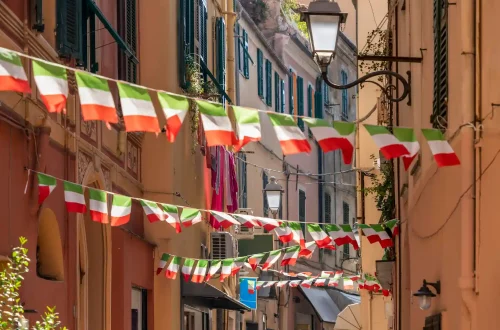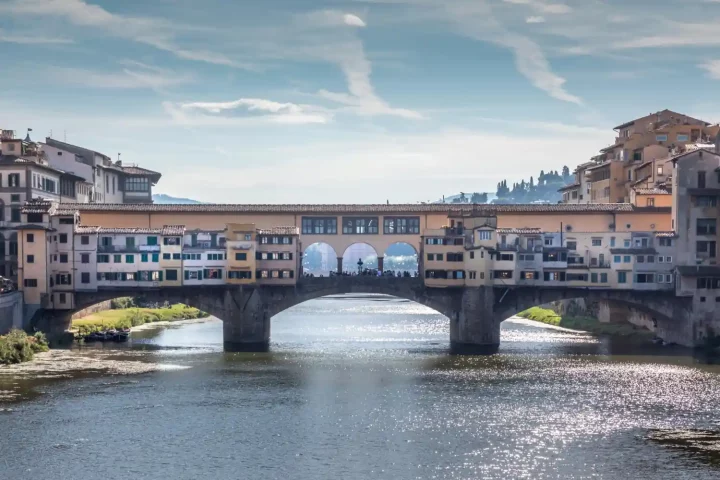The Ponte Vecchio, meaning “Old Bridge” in Italian, is one of Florence’s most iconic landmarks and a living testament to the city’s medieval heritage. Spanning the Arno River, it is the oldest bridge in Florence, originally constructed in 1218.
The current structure was rebuilt in 1345 after a devastating flood destroyed its predecessor. Designed by Taddeo Gaddi or possibly Neri di Fioravante—historians still debate the attribution—it was revolutionary for its time, combining functionality with architectural elegance.
Throughout its history, the Ponte Vecchio has served as a vital artery for commerce and communication. In the Middle Ages, it was lined with butcher shops, fishmongers, and tanners—Trades that were eventually banned to align with the refined image the Medici family wished to cultivate.
In 1593, Grand Duke Ferdinand I decreed that only goldsmiths and jewelers could occupy the bridge, transforming it into a refined shopping destination and preserving its aesthetic appeal.
Remarkably, the Ponte Vecchio survived World War II intact. While retreating German forces destroyed all other bridges in Florence, they spared the Ponte Vecchio—allegedly on direct orders from German Field Marshal Kesselring, who admired its beauty.
The Ponte Vecchio and its relevance to Florence
The Ponte Vecchio is a symbol of Florence’s resilience, creativity, and cultural identity. It reflects the city’s ability to blend practicality with artistry, serving as both a thoroughfare and a marketplace.
Its enduring presence through centuries of political change, natural disasters, and modernization speaks to Florence’s commitment to preserving its historical soul. The bridge also holds a special place in the hearts of Florentines. It’s a site of romantic gestures, artistic inspiration, and civic pride.
Locals and visitors alike stroll its cobbled path, admire its shop windows, and gaze out over the Arno River, connecting with the same views that inspired Renaissance masters.
Take advantage of specialized assistance to secure your passport for a borderless future.
Architectural features and materials
The Ponte Vecchio, originally designed as part of Florence’s medieval defense system, also reflects aesthetic intentions, with some design elements hinting at the involvement of Dominican Friars.
Unlike typical bridges, it featured built-in shop spaces that were leased to merchants by the medieval government.
The bridge is also connected to the Vasari Corridor, a passage commissioned by the Duke of Florence to link his residence at Pitti Palace with the Uffizi Gallery, allowing discreet movement above the bustling bridge.
Current function and preservation regulations
Today, the Ponte Vecchio functions as a pedestrian bridge and a hub for luxury shopping. Its jewelry shops continue the tradition established in the 16th century, offering gold, silver, and precious stones to discerning buyers.
Despite its commercial role, the bridge remains a public space, accessible to all and cherished for its historical ambiance.
Preservation of the Ponte Vecchio is a top priority for local and national heritage organizations. Strict regulations govern renovations, signage, and shop operations to maintain the bridge’s authenticity.
The city of Florence, along with UNESCO and other cultural bodies, monitors its condition and ensures that any restoration work respects its historical integrity.
Environmental factors, such as flooding and erosion, pose ongoing challenges. Engineers and conservationists regularly assess the bridge’s structural health, reinforcing foundations and repairing damage as needed.
These efforts ensure that the Ponte Vecchio remains safe and beautiful for future generations.
Take advantage of specialized assistance to secure your passport for a borderless future.
Cultural and touristic impact
The Ponte Vecchio is one of the most visited landmarks in Florence, drawing millions of tourists each year. Its blend of history, architecture, and commerce makes it a must-see destination for travelers from around the world.
Photographers capture its reflection in the Arno, artists sketch its contours, and couples leave love locks as tokens of affection.
Beyond tourism, the bridge plays a role in Florence’s cultural narrative. It has appeared in films, literature, and music, symbolizing romance, endurance, and artistic spirit. Its presence in global media reinforces Florence’s reputation as a city of beauty and history.
Economically, the Ponte Vecchio contributes to the local economy through tourism and retail. The shops employ artisans and jewelers, many of whom continue family traditions passed down through generations.
Events and festivals often center around the bridge, further enhancing its role as a cultural focal point.
Visiting tips and operating hours
To fully appreciate Ponte Vecchio, timing is key. Early mornings offer a peaceful experience, with soft light illuminating the river and fewer crowds. Sunset is another magical moment, as the golden hues reflect off the water and the bridge glows with warmth.
Most shops on the bridge are open from around 9:00 AM to 8:00 PM, though hours may vary. The bridge is accessible year-round and is located within walking distance of major attractions like the Uffizi Gallery and Palazzo Pitti.
Curiosities and historical facts
- Vasari Corridor: This elevated passageway allowed the Medici family to travel privately between their residences. It contains portraits and artworks and offers unique views of the city.
- WWII Survival: The Ponte Vecchio was the only bridge in Florence not destroyed by German forces during their retreat.
- Love Locks: While once popular, attaching locks to the bridge is now discouraged to protect its structure. Still, the tradition lives on in nearby areas.
Legacy and enduring Importance
The Ponte Vecchio is more than a bridge—it’s a living monument that embodies Florence’s history, artistry, and resilience. From its medieval origins to its modern role as a cultural and commercial hub, it has remained a constant in a city defined by change and creativity.
Its architectural uniqueness, historical depth, and emotional resonance make it a symbol not only of Florence but of Italy’s broader cultural legacy.
Whether you’re a first-time visitor or a lifelong admirer, the Ponte Vecchio offers a timeless experience that connects past and present in one unforgettable span.






